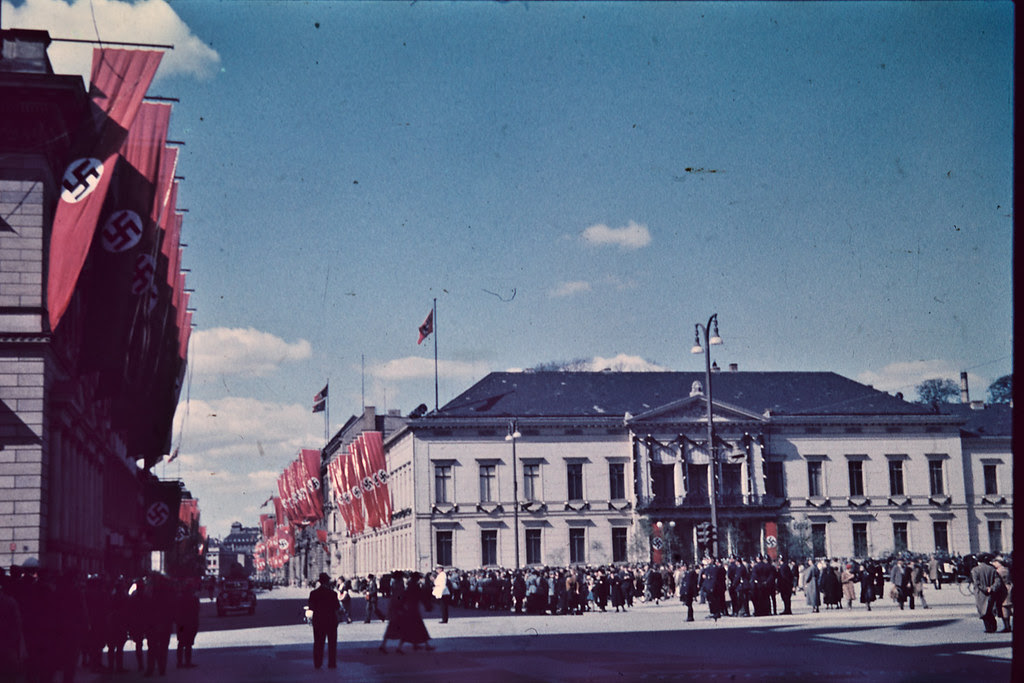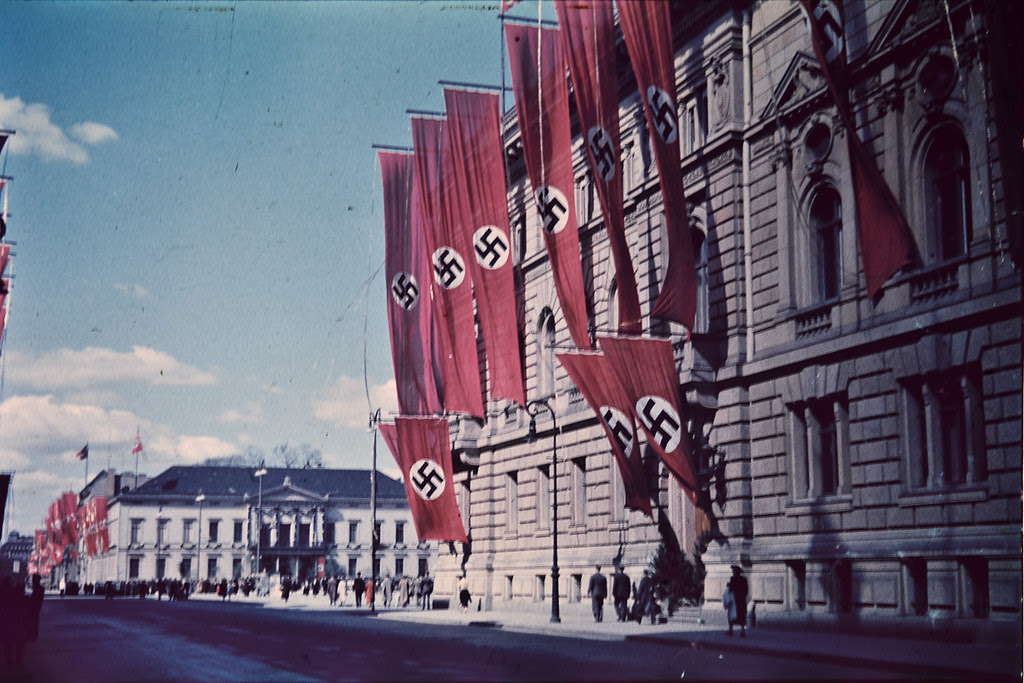.

In the streets of Berlin (camera: Leica / film: Agfa Color Neu): photo by Thomas Neumann, 1937 (National Archives of Norway)

Tyskland (Berlin) (camera: Leica / film: Agfa Color Neu): photo by Thomas Neumann, 1937 (National Archives of Norway)

Decorated streets in Berlin, Labour Day (May 1st)/Berlin's 700th anniversary. Flags and banners with swastika, cars with banners. Driver leaning towards a car.streets of Berlin (camera: Leica / film: Agfa Color Neu): photo by Thomas Neumann, 1937 (National Archives of Norway)

Decorated streets in Berlin, Labour Day (May 1st)/Berlin's 700th anniversary. Large crowd, flags with swastika, maypole (camera: Leica / film: Agfa Color Neu): photo by Thomas Neumann, 1937 (National Archives of Norway)

Berlin Cathedral (Berliner Dom). Decorated streets in Berlin, Labour Day (May 1st)/Berlin's 700th anniversary. Large crowd, flags with swastika, maypole (camera: Leica / film: Agfa Color Neu): photo by Thomas Neumann, 1937 (National Archives of Norway)

Berlin Cathedral (Berliner Dom). Decorated streets in Berlin, Labour Day (May 1st)/Berlin's 700th anniversary. Large crowd, flags with swastika, maypole (camera: Leica / film: Agfa Color Neu): photo by Thomas Neumann, 1937 (National Archives of Norway)

Decorated streets in Berlin, Labour Day (May 1st). Flags with swastika (camera: Leica / film: Agfa Color Neu): photo by Thomas Neumann, 1937 (National Archives of Norway)

Large crowds and decorated streets with Nazi banners, Labour Day (May 1st) in Berlin (camera: Leica / film: Agfa Color Neu): photo by Thomas Neumann, 1937 (National Archives of Norway)
Viewer comment (Mohammed H.), 2012: Woooaaah

Large crowds and decorated streets with Nazi banners, Labour Day (May 1st) in Berlin (camera: Leica / film: Agfa Color Neu): photo by Thomas Neumann, 1937 (National Archives of Norway)
Viewer comment (Tibor Kodal), 2012: What
a great capture. And a very intimidating sight as well...

Colour photography was made accessible to a greater audience in the last half of the 1930s. The companies Kodak (USA) and Agfa (Germany) competed in becoming the first to launch a method that would make colour photography with slides easy and cheap to use.
Kodak was first with their Kodachrome in 1935, and Agfa also patented their version in the same year, but the processing was very complicated. Agfa continued to work on their method, and in 1936 patented a colour film that was so easy to process that it could be made accessible to a large audience.
This new film was marketed as Agfacolor Neu and was accessible in the German stores from late 1936. Agfacolor Neu was thereby the first commercially successful colour film, and when the patent was released after World War II, the method was used by other producers. Kodak, on the other hand, had developed their own technical solution in 1937.
These photos are the first colour slides taken by an amateur photographer that we are aware of. In the spring and summer of 1937 the Norwegian engineer Thomas Neumann was an eager photographer of different motifs in Germany and Norway. The film he used was the first of its kind.
(National Archives of Norway)



8 comments:
Great shots, Tom. Third image doesn't load (for me). There don't seem to be too many "different" motifs... how strange...
love to you both, Tom
....and the Nazis he filmed were also the first of their kind, but judging from current political trends in Europe, i.e. Greece's Golden Dawn, not the last.
All loading o.k. now. T
Yeah, Tom R., the Nazis have never been too big on diversity...
It's amazing sometimes to remember that a the folks who appear in old photographs were in color. Someone colorized a Lincoln photo, and it was a bit shocking. Old paintings of kings, etc. are often closer to the mark... though glamorized, if you're a court painter. Did Hitler have blue eyes?
Thomas Neumann seems to have found a festival of cheerful red banners everywhere he looked, there in that bright Berlin springtime. What a great way to try out the latest German photographic equipment. Many of those boldly decorated venues would be bombed to rubble a few years later. The second shot, for example, gives us a long view of the then brand-new Messe Berlin fairgrounds in Berlin-westend, in the Charlottenburg-Wilmersdorf precinct opposite the Haus des Rundfunks. Thomas has "captured" the main building with entry hall at Masurenallee, built by Richard Ermisch, completed in 1937 -- later heavily bombed by Allied Aircraft, yet, in the awful fullness of time, rising phoenixlike out of its own ruins to host business conventions, electronics trade fairs and the like.
O wonderful forgetfulness of the New Millennium!
The diversity of Neumann's "motifs" having come under question, let it be said he used up the rest of the Agfacolor Neu stock he'd bought in Berlin for shooting the predictable hearty Nordic subjects, for example this scene aboard a sailboat in the Oslo fjord.
Meanwhile, as to the colour of the eyes of the Führer, there is testimony.
"Shakes my hand. Like an old friend. And those big blue eyes. Like stars. He is glad to see me. I am in heaven. That man has everything to be king." -- Josef Goebbels, upon first meeting Adolf Hitler
"By a detour we next reached a part of the building which was actually in flames. Firemen were pouring water into the red mass. Hitler watched them for a few moments, a savage fury blazing from his pale blue eyes." -- Sefton Delmer, Daily Express, 23 February 1933
"The first glance left me with a picture of a weak, soft face, with pouches under the eyes, full lips and very little bony facial structure. The mustache didn’t seem as ridiculous as it appeared in pictures – in fact, I scarcely noticed it; but I imagine that is because I was pretty well conditioned to such things by that time. As has often been said, Hitler’s eyes were startling and unforgettable – they seemed pale blue in color, were intense, unwavering, hypnotic. Certainly the eyes were his only distinctive feature. They could contain fury and fanaticism and cruelty; they could be mystic and tearful and challenging." -- Martha Dodd, Through Embassy Eyes
But let's leave the final verification to Agfacolour Neu, in
this shot that would have to have been taken shortly after the new film hit the market. (Technological progress, I believe that's called.)
Guten Morgen begins with Gilette
Ja, der Führer always took care with the grooming as with the camera supplies. It's thought the after-shave he preferred was the Bernoth brand, with its particular and unique successive waves of bouquet, first the fresh, fruity, citrusy fragrance of bergamot, followed by a woody, smoky, leathery aroma redolent of forest mass gravesites -- warm, full-bodied, dark, smoky, leathery, with just a soupçon of old oak moss, and the faintest reminder of the honey-like sweetness of vast steppes waiting to be overrun by Panzers, once the Engineering Division had done something about all that inconvenient weather, the mud & c. He attributed its characteristic strong "Cossack-y" smell to the birch tar, with which the leather was impregnated.
And as with the great camera supplies, the marketability of this quality product has not been much affected by the problematic ups and downs on history.
You can still get it today.
Well, research now indicates that while Hitler may well have been familiar with the new brands of safety razors in the 1930s, and used them, by later on in the decade he was accustomed to having the job done by staff, with regular upgrading to the more specialized service provided by Wollenhaupt, barber of the Kaiserhof Hotel, Berlin, who was brought in to headquarters for the obligatory short back and sides, with the odd shave likely included in the bargain.
In any case, what with the advance of the Parkinson's, AH would have had increasing difficulty with keeping the hand steady enoug for a proper auto-trim.
Hitler's vanity ought never be under-estimated.
Malaparte, who as a correspondent for Corriere della Serra had considerable early exposure, observed in 1931 that Hitler was in fact a woman.
"In Moscow I heard a Bolshevik, who was one of the most active instruments of Trotsky’s revolutionary tactics during the coup d’état of October 1917, pass this singular judgment upon Hitler: 'He has all Kerenski’s good and bad qualities and like Kerenski, he too is only a woman.'
"Hitler’s intelligence is in point of fact profoundly feminine: his mind, his ambitions, even his will are not in the least virile. He is a weak man who takes shelter in violence, so that he may conceal his lack of energy, his unexpected failings, his morbid egoism, and his clumsy pride. A quality common to nearly all dictators and one which is characteristic of their manner of judging men in relation to events, is their jealousy. Dictatorship is not only a form of government, it is also the most complete form of jealousy in all its aspects: political, moral and intellectual. Like all dictators, Hitler is guided much more by his passions than by his mind. His attitude towards his oldest partisans, the shock-troops who followed him from the very beginning, who stood by him in adversity, who shared his humiliation, dangers and imprisonment, who have been his glory and his power, can only be explained by jealousy. This will astonish only those who are unaware of the true nature of dictators, i.e., their violent and timid psychology. Hitler is jealous of those who have helped him to become one of the foremost figures in German political life. He is afraid of their pride, their energy, and their fighting spirit—that fearless, disinterested enthusiasm which turns Hitler’s shock-troops into a dangerous weapon of power. He exercises all his brutality to humble their pride, to crush their freedom of will, to obscure their individual merits and to transform his partisans into flunkeys stripped of all dignity. Like all dictators, Hitler loves only those whom he can despise. His ambition is to be able one day to debase and humble the whole German nation and to reduce it to a state of servitude, in the name of German liberty, glory and power."
Curzio Malaparte: The Technique of Coup d'Etat, 1931
Post a Comment